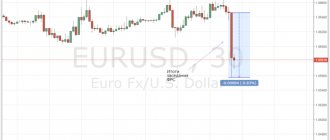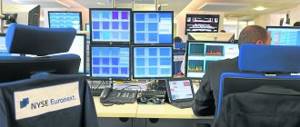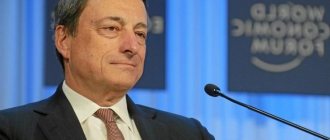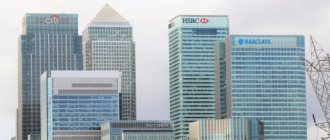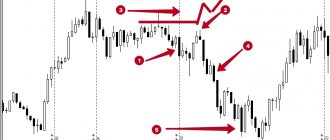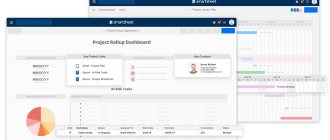Beige book
(English Beige Book), also
“Beige Book” of the US Federal Reserve
(
Fed's Beige Book
) is an economic review of the US Federal Reserve System, which is published on the basis of reporting documents of the 12 regional banks that are part of it.
The official title of the document: Summary of Commentary on Current Economic Conditions by Federal Reserve District
.
Story
The idea for this report was proposed by Arthur Burns, who became chairman of the US Federal Reserve in 1970. Before Burns, each of the presidents of regional banks presented at the Fed meeting information received from business contacts in their region. Burns believed that it would be more useful if the information was recorded and presented by the managers of the US Federal Reserve System before the meetings of the Open Market Committee.[1]
The Beige Book was first published in 1983. The Fed's Beige Book gets its name from the color of its cover.
On the 105th anniversary of the US Federal Reserve: The deceptions began at birth
America resisted the creation of a Central Bank for a long time, but then learned to use it to its advantage
On December 23, 1913, the US Congress passed the Federal Reserve Act. With lightning speed (on the same day), the law was signed by American President Woodrow Wilson. Based on this law, the US Federal Reserve System (FRS) was created in the country. This became a fateful decision that dramatically changed the vector of development of the United States and the entire world history. Many books and countless articles have been written about the Fed and the history of its creation. I will try to say something new or at least little-known in my article.
To briefly explain what the Fed is, it is the Central Bank of the United States. And a legitimate question immediately arises: why such a complex name, why not call the organization: “Central Bank of the United States of America”?
The answer is very simple: America did not want a Central Bank. Since the United States gained independence, there have been repeated attempts to create such an institution, but they all ended the same way: the closure of organizations.
In 1791, Congress established the First Bank of the United States, which performed the functions of the Central Bank, but in 1811 the organization ceased to exist. The Second Bank of the United States was created in 1816, but it too was closed in 1836. And then for almost eight decades the country lived without a Central Bank, although throughout this period bankers constantly made attempts to create such an institution. But these attempts were opposed by many politicians, including American presidents, industrialists and even ordinary citizens who understood what a central bank was (using the example of European countries where such institutions already existed).
Woodrow Wilson. Photo: www.globallookpress.com
The bankers went towards their cherished goal - the creation of the Central Bank - through gross violations of not only morality, but also the law, constantly resorting to deception and tricks. And so, in order to lull the vigilance of the “people’s representatives” on Capitol Hill, the authors of the bill invented the ingenious term “Federal Reserve System.” There was deception in each of the three words of the title.
Fed: what's "federal" about it?
The word “Federal” was intended to create the illusion that this is an institution of state power. In America there were and still are many government departments and organizations whose names begin with the word “Federal.” These are, for example, the Federal Bureau of Investigation (FBI), the US Federal Emergency Management Agency (as part of the Department of Homeland Security), the Federal Housing Administration (as part of the Department of Housing and Urban Development), etc.
In this regard, I remember a funny incident from my life. Somewhere almost thirty years ago I had to give a lecture on Soviet economics to students at an American university. In my speech, I drew attention to the fact that in the USSR the Central Bank is a state institution, and in America it is a private one. The audience became noisy, the students began to be indignant and say that the lecturer from Moscow does not know the American economy well. After all, the American Central Bank, in their firm belief, is state-owned. Why? Yes, because its name begins with the word “Federal”.
Unexpectedly, one smart student came to my rescue, who saw a telephone directory in the classroom - a thick book. Those who have come across such directories know that private organizations are in one section, and public organizations are in another. And the US Federal Reserve, as one would expect, found itself in the section of private organizations. Next to Federal Express, a well-known American company providing postal services. So much for the vaunted “brilliant” American university education!
Baron David de Rothschild. Photo: www.globallookpress.com
It is possible that some of the “people’s representatives” in the US Congress 105 years ago believed that they were voting for the establishment of some kind of state institution. In fact, the Fed can be characterized as a private, closed corporation. The list of the first major shareholders (shareholders) of the corporation is known: the Rothschilds, Morgans, Warburgs, Rockefellers, Lazars, Lehmans, Schiffs, Kuhns, Loebs, etc.
It is noteworthy that many of the shareholders were European rather than American bankers. Key positions in the Federal Reserve at the time of its creation belonged to the Rothschilds and Morgans, and the latter were considered agents of the Rothschilds in America. Then, of course, there were changes in the capital structure of the Federal Reserve, but this is a topic for another discussion.
Fed: why is it “reserve”?
The word “Reserve” was intended to convince skeptics and opponents: the new institution would become a reliable guarantor that in the future America would not face any banking or other crises.
Let me remind you that in 1907, bankers interested in creating the American Central Bank carried out a kind of “artillery preparation”. The key figure in those events was the banker John Pierpont Morgan. The history of the banking crisis of 1907 is extremely interesting. The crisis was initiated by bankers who sought to create a Central Bank. With the help of the newspapers they controlled, they provoked a banking panic and a customer run on a number of American banks. A pool of private investors led by Morgan acted as the “savior” of these banks. The crisis was stopped. But the events served as an impetus for discussions on the issue that the US banking system needs a permanent “savior”, and this can only be the Central Bank, playing the role of “lender of last resort”. And in order for him to fulfill such a role, he needs money, which commercial banks must transfer to a special reserve fund.
Photo: www.globallookpress.com
But no “reserve contributions” can be a guarantee or reliable protection against crises. Crises will disappear only if banks are deprived of the right to “make money out of thin air.” But the 1913 Law did not provide for this, so the word “Reserve” in the name of the new organization was a deception.
Yes, banks that joined the Fed began to make reserve contributions to the centralized fund, but they did not save from serious imbalances in the banking system. In US history, after the creation of the Federal Reserve System, there were several major banking crises, and some of them went beyond the banking system and provoked financial and economic crises.
It sounds paradoxical, but Fed shareholders are even interested in crises (banking, financial, economic). Crises are big business, during which shareholders of the Federal Reserve, who have in their hands the “printing press” (a means of issuing money), buy up the assets of bankrupt people, and the prices for these assets fall significantly during periods of crisis. Thus, capital and assets are concentrated in the hands of the owners of the “printing press”.
Today, many historians and economists come to the conclusion that the global economic crisis of the 1930s. was provoked by Fed shareholders (stock market panic in October 1929). You can read about this, in particular, in the following book: William F. Engdahl. The invisible hand...of banks. (Translated from English - M.: Selado, 2017).
So, the word “Reserve” turns out to be just as crafty as the word “Federal”.
Fed: why "system"?
The word “System” turns out to be no less crafty. The “people’s representatives” of the beginning of the last century were instilled with the idea that there would be no Central Bank in the country, we were only talking about creating a system or network of “key”, or, as they say today, “systemically important” banks. They say that there should not and cannot be a centralized institution like the Bank of England or the Bank of France in a “free” America.
In the draft law, which was prepared by the bankers’ henchmen, the number of such “key” banks changed several times. But, in the end, they settled on the number 12 Federal Reserve Banks, the Federal Reserve Bank (some researchers see some mystical and esoteric meaning in this figure). Commercial banks are shareholders of the Federal Reserve Bank, make their reserve contributions to the Federal Reserve Bank and can count on assistance from their Federal Reserve Bank in the event of a threat of default (bankruptcy). The activities of the Federal Reserve Bank are coordinated by the Federal Reserve Board of Governors, consisting of seven people and headed by a chairman. The first chairman was Charles S. Hamlin. The current current (sixteenth) Chairman is Jerome Powell (since February 5, 2021).
To explain the structure of the system, the words from George Orwell's story “Animal Farm” are very suitable: “All animals are equal, but some animals are more equal than others.”
Technically, all 12 Federal Reserve Banks are equal, but among them there is one that is “more equal” than the other 11. This is the Federal Reserve Bank of New York. It accounts for about half of all assets and all liabilities of the banks that make up the US Federal Reserve System (the number of member banks has varied in recent years in the range of 2.5 - 3 thousand). The members of the New York Fed are the leaders of the American banking world - Wall Street banks. Moreover, the New York Fed has exclusive rights to conduct international transactions. The president of the Reserve Bank also has a standing vote at meetings of the Open Market Committee, which sets federal funds interest rates. And the remaining 11 banks receive voting rights on a rotation basis.
In reality, US monetary policy is carried out by the US Federal Reserve Board of Governors together with the governors of the New York Federal Reserve Bank. The remaining Federal Reserve Banks occupy a subordinate place in the US Federal Reserve System. There is no decentralization in the US Federal Reserve System; there is a strict administrative command vertical. You can learn more about this from the following book: Murray Rothbard. History of money circulation and banking in the USA (Translation from English - Chelyabinsk: Sotsium, 2005).
A revolution that historians missed
So, the birth of the US Federal Reserve began with deception. The creation of the American Central Bank was camouflaged with the crafty sign “US Federal Reserve System”. But, in addition to deception, there was also a gross violation of the US Constitution, which determines that the right to issue money belongs to Congress (Article 1, Section 8, Clause 5). Let me remind you that simultaneously with the adoption of the law on the US Federal Reserve, the US Congress passed a law introducing a federal income tax on individuals in the country, which also contradicted the US Constitution. This is not accidental, because a system was created that was supposed to “feed” the bankers on an ongoing basis: 1) The state issues debt securities that are bought by the US Federal Reserve; 2) The state services its debts to the Federal Reserve through taxes collected from the people.
The Fed is not only a mechanism for robbing the people. The Fed is the power over the country.
Photo: www.globallookpress.com
We usually say that the institution of power is the state with its three branches - legislative, executive and judicial. The Central Bank does not appear at all in this beautiful picture. It was taken out of this picture, slyly giving it the status of an “independent” institution. The most daring and meticulous researchers make a “discovery”: they say that the Central Bank is also a power, but not enshrined in the constitution. The Central Bank is called the fourth or fifth power (if we consider the media as the fourth, unofficial power).
But I can only partially agree with such “discoveries.” In fact, the Central Bank is the first power.
This is an institution that is created as a result of bourgeois revolutions, prepared and carried out by moneylenders. A “glorious revolution” took place in England - in 1694 the Bank of England was created. There was a revolution in France - in 1800 the Bank of France was created. In Japan, in the second half of the 19th century, the “Meiji Revolution” unfolded - in 1882, the Bank of Japan was established. And everywhere the creation of a true institution of power was hidden behind a fig leaf called “parliament”. In our history textbooks they write that bourgeois revolutions were carried out for the sake of creating parliaments. A gross mistake, a misunderstanding of the essence of things! Revolutions were organized for the sake of moneylenders obtaining a monopoly right to print money.
One of the Rothschilds cynically said:
Give me the right to print money, and I don’t care who writes what laws.
But in the United States, after the signing of the Declaration of Independence in 1776, as many as 137 years passed before the moneylenders finally managed to create the Federal Reserve System. The founding fathers of America and their ideological followers themselves wanted to rule the country. They came from Europe and understood well what the Central Bank was and how great its power was.
Suffice it to quote the words of one of the founding fathers, Thomas Jefferson:
If the American people ever allow the banks to control the issue of their currency, first by inflation and then by deflation, the banks and corporations that will spring up around them will deprive the people of all their property, and their children will find themselves homeless on the continent that their fathers took possession of. The power to issue money must be taken away from the banks and returned to Congress and the people. I sincerely believe that banking institutions are more dangerous to freedom than regular armies.
(These words were spoken during the period when the First Bank of the United States was operating, which Jefferson opposed).
The main shareholders of the Fed are the “masters of money” and the “masters of America”
After the adoption of the Federal Reserve Act, America lost its sovereignty and began to be controlled by the main shareholders of this private corporation. I call them “money owners.” But they simultaneously became the “masters of America,” and their ambitions extend much further. They wanted and want to become “masters of the world,” and turned America into a springboard for achieving this goal. By the way, it is no coincidence that the First World War in Europe began just a few months after the establishment of the Federal Reserve System. For those who are interested in this topic, I can recommend my book, which I wrote for the 100th ominous anniversary of the Federal Reserve: “Masters of Money. 100-year history of the Federal Reserve System" (M.: Algorithm, 2014).
I will not describe now what consequences the creation of the Fed led to America. Woodrow Wilson, who signed the Federal Reserve Act on December 23, 1913, wrote much later (after leaving the White House):
I am the most unhappy person. Without understanding what I was doing, I destroyed my country. The most powerful industrial power is dominated by its debts. All debts flow into one common debt. National growth and everything we do is in the hands of a few people. We turned out to be the most weak-willed, most subservient and controlled government in the civilized world. We are no longer a government of the people's will, a government elected by the majority, but a government under the rule of a small number of people.
But, alas, Wilson's insight came too late.
Content
Overall, the report reflects the current state of the industrial production, labor market, real estate, financial industry, banking sector, agriculture and service industries in US regions. The report is compiled from informal comments collected by each Federal Reserve Bank in its district. Listen to reports from directors of banks and their branches, including reports from chief economists, market experts, and entrepreneurs. The Beige Book is considered an important tool for checking the overall stability of the economy[2].
The Beige Book is one of three books offered by regional banks to the Open Market Committee. Meeting members also receive a Green book
) - a national forecast for the next two years, carried out by the department of economic research and statistics of the Board of Governors and the Blue Book
containing
forecasts for the development of monetary policy[3][4].
The Beige Book is the Fed's only publicly available book and is published eight times a year, on Wednesdays two weeks before the Federal Open Market Committee (FOMC) meets at 2:15 pm EST (10:00 pm Moscow time). time). The book is published free of charge and is freely available on the official website of the US Federal Reserve[5].
Beige Book structure
In 2021, the format for publishing economic indicators is reduced to a general essay in sections:
- Economic activity
- Employment and wages
- Rising prices
- Special notes on the state of the economy in 12 large administrative centers
Next comes a more introductory overview of each monitored parameter of the state of the economy for individual districts. Detailed details of the report are disclosed on the websites of each of the 12 branches of the Federal Reserve System.
Notes
- [forexaw.com/TERMs/Exchange_Economy/Macroeconomic_indicators/Other_macroeconomic_indicators/l1276_%D0%91%D0%B5%D0%B6%D0%B5%D0%B2%D0%B0%D1%8F_%D0%BA%D0%BD %D0%B8%D0%B3%D0%B0_Beige_Book_%D1%8D%D1%82%D0%BE Beige Book - economic review of the US Federal Reserve]
- [vertiforex.ru/resursi/ekonomicheskie-indikatori/bejevaya-kniga/#.VAa5fKNfbeg Beige book]
- [economic-info.biz/teoriya-deneg/vrezka-144-vnutri.html Box 14.4. Inside the Fed: Green, Blue and Beige Books]
- [www.investopedia.com/terms/b/beigebook.asp Beige Book Definition | Investopedia]
- [www.federalreserve.gov/monetarypolicy/beigebook/default.htm FRB: Beige Book]
Links
Documentation Beige Book • Federal Reserve Statistical Review • Report to Congress on Monetary Policy • FedSpeak Federal funds Discount window • Fed Funds • Fed Funds Rate • History of the Federal Open Market Committee • Primary Dealer Story Aldrich-Vreeland Act • Federal Reserve Act • Institutional Deregulation and Financial Control Act • History of the US Central Bank
The impact of the Beige Book economic review on stock indices and the Forex market
Federal officials report based on current statistics, so investors and speculators view facts and figures as lagging indicators that confirm market trends. In the short term, the Beige Book affects the US dollar if the Fed rate is expected to change. In this case, any discrepancies between the survey statistics and previously published indicators on consumer and business expectations, the labor market and wages may cause:
- If exceeded - a sharp strengthening of the US dollar index
- On the downside – the depreciation of the US dollar against the main national currencies
Investors pay attention to the conclusions and results of the report - pessimistic comments can lead to a fall in indices, causing the sale of shares, an optimistic view stimulates purchases in sectors marked by growth and comments about the preservation of future prospects.
Excerpt characterizing The Beige Book
- Why is this so? – asked Pierre. - Yes, at least about firewood or feed, I’ll report to you. After all, we were retreating from the Sventsyans, don’t you dare touch a twig, or some hay, or anything. After all, we are leaving, he gets it, isn’t it, your Excellency? - he turned to his prince, - don’t you dare. In our regiment, two officers were put on trial for such matters. Well, as His Serene Highness did, it just became so about this. They saw the light... - So why did he forbid it? Timokhin looked around in confusion, not understanding how or what to answer such a question. Pierre turned to Prince Andrei with the same question. “And so as not to ruin the region that we left to the enemy,” said Prince Andrei with malicious mockery. – This is very thorough; The region must not be allowed to be plundered and the troops must not be accustomed to looting. Well, in Smolensk, he also correctly judged that the French could get around us and that they had more forces. But he couldn’t understand that,” Prince Andrei suddenly shouted in a thin voice, as if breaking out, “but he couldn’t understand that we fought there for the first time for Russian land, that there was such a spirit in the troops that I had never seen, that We fought off the French for two days in a row and that this success increased our strength tenfold. He ordered a retreat, and all efforts and losses were in vain. He didn’t think about betrayal, he tried to do everything as best as possible, he thought it over; but that’s why it’s no good. He is no good now precisely because he thinks everything over very thoroughly and carefully, as every German should. How can I tell you... Well, your father has a German footman, and he is an excellent footman and will satisfy all his needs better than you, and let him serve; but if your father is sick at the point of death, you will drive away the footman and with your unusual, clumsy hands you will begin to follow your father and calm him down better than a skilled but stranger. That's what they did with Barclay. While Russia was healthy, a stranger could serve her, and she had an excellent minister, but as soon as she was in danger; I need my own, dear person. And in your club they made up the idea that he was a traitor! The only thing they will do by slandering him as a traitor is that later, ashamed of their false accusation, they will suddenly make a hero or a genius out of the traitors, which will be even more unfair. He is an honest and very neat German... “However, they say he is a skilled commander,” said Pierre. “I don’t understand what a skilled commander means,” said Prince Andrey with mockery. “A skillful commander,” said Pierre, “well, the one who foresaw all the contingencies... well, guessed the thoughts of the enemy.” “Yes, this is impossible,” said Prince Andrei, as if about a long-decided matter. Pierre looked at him in surprise. “However,” he said, “they say that war is like a chess game.” “Yes,” said Prince Andrei, “only with this small difference that in chess you can think about every step as much as you like, that you are there outside the conditions of time, and with this difference that a knight is always stronger than a pawn and two pawns are always stronger.” one, and in war one battalion is sometimes stronger than a division, and sometimes weaker than a company. The relative strength of the troops cannot be known to anyone. Believe me,” he said, “if anything depended on the orders of the headquarters, I would have been there and made the orders, but instead I have the honor of serving here, in the regiment with these gentlemen, and I think that we really tomorrow will depend, not on them... Success has never depended and will not depend on position, weapons, or even numbers; and least of all from the position.
The importance of the Fed and its tasks
It is difficult to underestimate the importance that the Fed plays in the modern world. The effect of his actions is enormous and has a global impact.
The interest rates for which he is responsible are extremely important. As practice has shown, ideally it should be around 2-4%. In this case, smooth GDP growth is achieved without jumps and crises.
Too rapid economic growth inevitably leads to collapse. This can be explained as follows: the country begins to produce more. People's salaries are rising, everyone is starting to consume more.
Industry is increasing its capacity. However, demand is growing faster than factories are able to expand their production. This results in a situation where demand exceeds supply. Companies begin to raise prices, inflation begins to rise. Which leads to a reverse circle, when supply begins to exceed demand, and prices are expensive.
Salaries are falling, demand is falling sharply, warehouses are filled with unsold goods. Production is idle because the old one must first be sold off. A crisis is coming. At such a moment, the Fed must fight inflation by raising interest rates, which leads to a slowdown in the issuance of loans and spending by the population.
The Fed always deals with a very difficult issue regarding interest rates, since any careless movement can cause serious problems in the US economy and then in the global economy.
The key rate determines the “strength” of the dollar in the world. And since most trade transactions and transfers are calculated in it, any small change leads to large changes in other industries. Currency pairs involving USD on Forex and the stock market react especially sharply.


